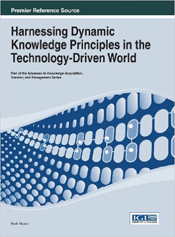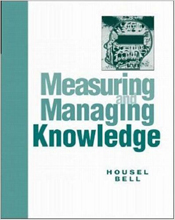IS Department Publications - Information Sciences
Information Sciences Department Publications
Books & Chapters

Harnessing Dynamic Knowledge Principles in the Technology-Driven World
by Mark E. Nissen
In a technology-driven world, it is essential that enterprises develop reliable and rapid flows of knowledge to distribute evenly across organizations, time and place, and individuals in order to sustain a competitive advantage. However, most leaders and managers are unacquainted with effective knowledge flow practices.
Harnessing Dynamic Knowledge Principles in the Technology-Driven World provides actionable principles of Knowledge Flow Theory to identify and solve problems for implementing these principles into practice. With emerging developments and widespread applicability, this book is a practical guide for scholars, business managers, and enterprise leaders and managers interested in understanding the dynamics of knowledge flows for competitive advantage in a technology-driven world.
 Measuring and Managing Knowledge
Measuring and Managing Knowledge
by Thomas J. Housel
Measuring and Managing Knowledge provides a framework for managing and maximizing the return on intellectual capital. Like any emerging field, knowledge management has so far been hobbled by a lack of clarity on key questions: What do we mean by "knowledge"? How can it be measured and managed? How can return on knowledge (ROK) be maximized? To answer these questions, the authors avoid the obtuse language of sociology and economics in favor of plain talk. They weave the central insights of the growing body of knowledge management literature and their own research into a clear, compelling story of what knowledge management is at present and will become in the years ahead.
Technical Reports
Development of a Big Data Application Architecture for Navy Manpower, Personnel, Training, and Education
by Magdi Kamel
Navy Manpower, Personnel, Training, and Education (MPTE) decision makers require improved access to the information obtained from the vast amounts of data contained in a number of disparate databases/data stores in order to make informed decisions and understand second- and third-order effects of those decisions. This research examined and proposed an end-to-end application architecture for performing analytics for MPTE and developed a decision tree model to predict retention of post-command aviators, using the Cross-Industry Standard Process for Data Mining (CRISP-DM).
Understanding and Retaining Talent in the Information Warfare Community
by Mark E.& Nissen and Simona L.Tick
The Navy Information Warfare Community (IWC) provides a vital, sophisticated capability to address increasingly dynamic and unpredictable threats around the world. The problem is, the same skills and capabilities that make IWC personnel so valuable to the Navy also make them valuable to myriad firms in industry and organizations elsewhere beyond the Services. This qualitative study addresses the issue directly, building up a grounded understanding of IWC talent and identifying both positive and negative issues driving talented people’s decisions to leave or stay in the Navy.
SJFHQ Simulation
Shelley Gallup, Susan Hutchins
A four level architecture has been developed for SJFHQ processes. This architecture has been used to develop a simulation of SJFHQ operations. Correct simulation performance has been verified and initial results produced. The results focus on personal work tasking and multi-tasking effects.
Human Interoperability: experimentation to understand & improve the human component of complex systems
Shelley Gallup
The Human Interoperability (HI) initiative is intended to improve the responsiveness, efficiency, and effectiveness of organizations when they partner externally or internally. This document reports findings from initial research, led by OSD NII, to explore the discipline and dimensions of HI. The goals of the research team were to develop theory concerning HI, capture and analyze initial evidence of barriers to organizational collaboration, and to outline objectives for future research.
Maritime domain awareness risk reduction limited objective experiment
Doug MacKinnon, Susan Hutchins, Shelley Gallup
A risk reduction experiment was performed to identify and alleviate any risks to successful completion of the FAIRGAME test of MDA Spiral-1 systems. Identified risks and mitigation actions are reported.
